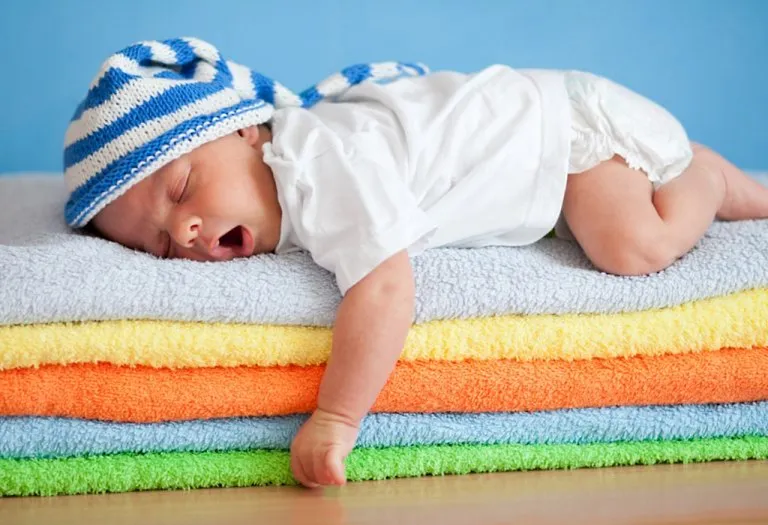Mustard Pillow (Rai Pillow) for Baby – How to Make & Benefits
- What Is Mustard Seed Pillow?
- When and Why to Use Mustard Seed Pillow for Babies?
- How to Make Mustard Baby Pillow at Home?
- Benefits of Using Rai-Filled Pillows for Babies
- Risks of Using Mustard Seeds Pillow for Infants
- Precautions to Take While Using the Mustard Pillow for Babies
- FAQs
India, with its rich tapestry of traditions and superstitions, holds a unique approach to childbirth and child-rearing. Among the many myths, the country harbors ancient remedies some of which are backed by science. During birth, the softness of a baby’s head renders it highly malleable, and susceptible to molding. However, the journey through the birth canal can sometimes result in elongation or deformation of the head’s natural shape. This is where the age-old practice of using a mustard pillow as a remedy emerges.
The mustard pillow for baby, a quintessential element of traditional Indian childbirth practices, is believed to possess properties that aid in rectifying such deformities. These pillows offer gentle support to the baby’s head, allowing for a more natural and symmetrical development.
What Is Mustard Seed Pillow?
A mustard pillow for a newborn is simply a pillow that is filled up with mustard seeds. The fabrics are soft and breathable and the cushioning effect is such that it’s perfect for rounding the head of the babies.
When and Why to Use Mustard Seed Pillow for Babies?
You should use a mustard pillow for your child if you want their head shape to turn out round. The bones in their body (including the skull) are soft and can be moulded within 18 months from the time of birth, giving you plenty of time to take advantage of this natural solution. However, you’ll lose hope if two of the baby’s fontanelles close up so you have to start using this early for best results.
How to Make Mustard Baby Pillow at Home?
Making a rai pillow for a newborn baby is easy. Here’s a brief on making mustard pillow for baby at home.
- Rinse the mustard seeds in water and sundry them completely until no moisture remains.
- Get a meter of muslin cloth, wash it in hot water, and dry it thoroughly. Drying the cloth and the seeds is very important since any moisture left may lead to the growth of fungi or moulds in the pillow.
- Make a 10×15-inch pillow out of that and stitch up 3 out of the four sides, keeping one as the opening for the filling
- Fill up 3/4 of the pillow with mustard seeds and leave a 1/4 gap. Too many seeds make the pillow hard while too few make it way too soft so you’re ideally striking a balance.
- Seal up the fourth side to finish the pillow and restitch all the sides three to four sides to make sure the mustard pillow lasts through repeated uses
- Buy a bunch of extra muslin pillow covers so that you can wash them and keep them for later use
Benefits of Using Rai-Filled Pillows for Babies
There are numerous benefits of using a mustard pillow for infants. Here’s what you want to know about them below.
1. Provides Ergonomic Support to the Baby’s Head
A mustard pillow effectively cushions the baby’s head and provides ergonomic support. Its cushioning effect is perfect for tender skulls and it gently reshapes the head in three to four weeks without adding any stress or pressure
2. It Adapts to The Baby’s Movement
This is one of the most important benefits of mustard pillow for babies. Mustard pillows don’t lose their shape easily. In fact, whenever your baby turns their head around, it’ll conform to their movements, be it left or right. This helps to make sure their head shape stays uniform and doesn’t tilt or get too exaggerated on either side.
3. Warms The Head Naturally
Mustard seeds have certain vitamins, minerals, and properties which warm up a baby’s head naturally. If your baby is suffering from the common cold or cough, you’ll find that a mustard pillow will provide them with much-needed relief.
4. Prevents Placing Pressure on One Side
Another benefit of using mustard pillows is that it doesn’t allow your baby to put pressure on their head when they sleep on their desired side. Sometimes babies have a tendency to tilt or fix their heads in a certain position, which further adds pressure to the neck and skull, thus deforming it. But this pillow prevents that by adapting to those positions and taking the pressure off. It’s just impossible to stress the bones with a mustard pillow below their head.
5. Fixes Bumps and Dents
If your baby has any deformities in the skull post-childbirth like dents, bumps, depressions, or any weird shape to the skull, a mustard pillow will fix that. The best part is that these pillows lower the risk of a baby acquiring a flat head.
6. Promotes Comfortable Sleep
The gentle warmth provided by a mustard pillow can help soothe babies, promoting deeper and more comfortable sleep. This can be particularly beneficial for fussy or colicky babies who may struggle to settle without proper support.
7. Encourages Relaxation and Calmness
The natural warmth and snugness offered by a mustard pillow create a cozy environment that promotes relaxation and calmness in babies. This can be especially beneficial during times of fussiness or agitation, helping babies settle more easily.
8. Enhances Bonding During Feeding and Cuddling
Using a mustard pillow during feeding or cuddling sessions can enhance bonding between the baby and the caregiver. The comfortable support provided by the pillow allows for closer physical contact, fostering feelings of security and connection for both the baby and the parent or caregiver.
9. Assists in Postural Development
Using a mustard pillow can aid in the baby’s postural development by providing gentle support to the head and neck. This support encourages proper alignment of the spine and helps promote healthy posture as the baby grows and develops.
Risks of Using Mustard Seeds Pillow for Infants
Using a mustard seeds pillow for infants, while rooted in tradition, carries certain risks that parents should consider before opting for this practice. According to the provided link, here are some potential risks associated with mustard seed pillows:
1. Choking Hazard
Mustard seed pillows contain small seeds that could pose a choking hazard to infants if the pillow were to tear or break open. Infants are particularly vulnerable to choking incidents, so it’s essential to ensure that any bedding or pillows in their environment are safe.
2. Allergic Reactions
Some infants may have allergic reactions to mustard seeds or other materials used in the pillow. Allergies can manifest as skin irritations, respiratory issues, or other symptoms, so it’s crucial to monitor the baby closely for any signs of allergic reactions.
3. Heat Generation
Mustard seeds have a natural ability to generate heat when compressed. While this may provide warmth, excessive heat can be uncomfortable for infants and may contribute to overheating, which is a risk factor for Sudden Infant Death Syndrome (SIDS).
4. Risk of Overheating
In addition to the heat generated by mustard seeds, the pillow itself may retain heat, potentially leading to overheating if the baby’s head remains in prolonged contact with it.
5. Suffocation Risk
Like any pillow or soft bedding, a mustard seeds pillow can pose a suffocation risk if the infant’s face becomes buried in it, obstructing their airway. This risk is particularly significant for newborns and young infants who may not have the strength or mobility to reposition themselves.
Precautions to Take While Using the Mustard Pillow for Babies
When using a mustard pillow for babies, it’s crucial to take certain precautions to ensure the safety and well-being of your little one. While this traditional practice can offer benefits, it’s essential to be mindful of potential risks and take appropriate measures to mitigate them.
1. Supervision is Key
Always supervise your baby when using a mustard pillow, especially during sleep or nap times. This helps to prevent any accidental suffocation or choking hazards that may arise if the baby’s face becomes buried in the pillow.
2. Ensure Proper Pillow Construction
Make sure that the mustard pillow is securely constructed, with no loose seams or openings that could lead to spillage of mustard seeds. Check the pillow regularly for any signs of wear and tear, and replace it if necessary to maintain its integrity.
3. Optimal Pillow Placement
Place the mustard pillow under the baby’s head in a way that provides gentle support without obstructing the airway. Avoid positioning the pillow too close to the face or allowing the baby’s head to sink too deeply into it, which could increase the risk of suffocation.
4. Monitor for Allergic Reactions
Keep an eye out for any signs of allergic reactions in your baby, such as skin rashes, itching, or respiratory symptoms. If you notice any unusual reactions after using the mustard pillow, discontinue its use immediately and consult with a healthcare professional.
5. Maintain Comfortable Temperature
Ensure that the room temperature is comfortable and not too warm when using the mustard pillow, as mustard seeds have a natural tendency to generate heat when compressed. Avoid overheating by dressing your baby in light clothing and monitoring their temperature regularly.
FAQs
1. When should I stop using a mustard pillow for my baby?
As your baby grows and becomes more mobile, it’s wise to reassess the use of a mustard pillow. If you notice any discomfort or if your baby begins to roll over or move around more during sleep, it may be time to discontinue using the pillow. Always prioritize your baby’s safety and comfort.
2. Can I wash a mustard pillow?
Most mustard pillows are not washable due to the nature of the mustard seed filling. However, you can spot-clean the outer fabric of the pillow if necessary. Be sure to follow any specific care instructions provided by the manufacturer or consult with a healthcare professional for guidance.
3. Are there alternative materials I can use instead of mustard seeds for a baby pillow?
Yes, if you’re concerned about using rai pillow for baby or if your baby has allergies, there are alternative materials you can use to make a baby pillow. Rice, millet, or buckwheat hulls are commonly used as fillings for baby pillows and may offer similar benefits without the risk of allergic reactions associated with mustard seeds.
You should avoid massaging a baby’s head forcefully when you’re using these mustard pillows. This is because a baby’s fontanels are too delicate and too much pressure may permanently harm the baby. Just make sure your baby uses the mustard pillow and keeps his head on that often. This way, you’ll slowly but surely notice the results coming out with the least possible harm.
Also Read:
Should Babies Sleep Using Pillows?
Benefits of Mustard Oil for Baby Massage
Feeding Pillow – Benefits and How to Use It
Was This Article Helpful?
Parenting is a huge responsibility, for you as a caregiver, but also for us as a parenting content platform. We understand that and take our responsibility of creating credible content seriously. FirstCry Parenting articles are written and published only after extensive research using factually sound references to deliver quality content that is accurate, validated by experts, and completely reliable. To understand how we go about creating content that is credible, read our editorial policy here.























